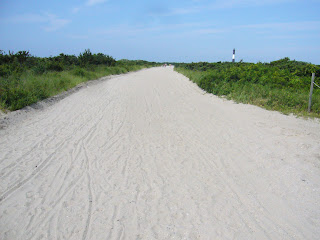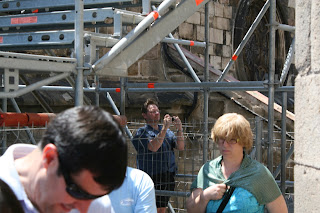I was fortunate enough to be able to have weekend access one of my Luzzo’s cycling team mate’s car equipped with roof racks. I wasn’t sure if it was going to be more affordable to drive there or take public transportation. So I did some research.
Costs of getting there
Turns out if your party is 2 or more people and you have a car, I think driving there is the most affordable (and fastest) option
Round Trip Car Expenses from Manhattan: $28 (Tolls $11.00, Gas $10, Parking $7)
Round Trip Using Public Transportation (per person): $26 (Rail: $12, Ferry:$14)
Fire Island
I had heard that there is extremely limited automobile access to Fire Island. Being a cyclist, I got excited about this thinking it could be a possible cyclist’s paradise. Since we had the roof racks on the car, I loaded up our road bikes with tires fit for riding on dirt surfaces.
The road to Robert Moses across the bay.

We drove from our place in Northern Manhattan to Robert Moses State Park where there are at least 3 huge parking fields with convenient beach access. We made a point of leaving by 8:30am on Saturday morning to ensure we were beating most of the hung over city-dwellers that may have had the same idea. We got there in about 50 minutes – no problems with traffic. Easy.
There was plenty of parking at Robert Moses State Park. We parked, and took off on the bikes north. Riding was easy at first – hard-packed dirt roads which passed the lighthouse.
 We had to walk the bikes for about 10 minutes until the edge of Saltaire, the first town north of the parking area. No cars, other than the local’s, are allowed here.
We had to walk the bikes for about 10 minutes until the edge of Saltaire, the first town north of the parking area. No cars, other than the local’s, are allowed here.(above) Sandy roads not suited for a bikes - this is one of the barriers the locals use protect their towns from annoying bikers, I guess. The other is not to allow bikes aboard the ferries.
Saltaire
 A modest-looking abode in Saltaire
A modest-looking abode in Saltaire Fences protecting the dunes on quiet beach in Saltaire. I can't believe we are less than 1 hour from the city!
Fences protecting the dunes on quiet beach in Saltaire. I can't believe we are less than 1 hour from the city! Looks like it's time to clean the camera's sensor.
Although I am not sure, judging from the number of boats on the bayside, I think that most of the residents have their own boat transportation to/from the island and park their cars on the mainland. We did a little tour of the docks and found some pretty impressive boats.

 give me 1/4 of what this boat costs and I'll get more positive utility from it than its owner. Below are shaded, wooded walkways of Saltaire.
give me 1/4 of what this boat costs and I'll get more positive utility from it than its owner. Below are shaded, wooded walkways of Saltaire. Houses in Fire Island seem modest relative to how much they actually cost. Some of the pictures show that “simple” seems to be the common theme around Saltaire. I perused the local grocery store and didn’t see anything truly gourmet and the small restaurants seemed to be geared for day tourists. Most of the locals may shop inland. A good number of the homes that we saw were for rent.
Houses in Fire Island seem modest relative to how much they actually cost. Some of the pictures show that “simple” seems to be the common theme around Saltaire. I perused the local grocery store and didn’t see anything truly gourmet and the small restaurants seemed to be geared for day tourists. Most of the locals may shop inland. A good number of the homes that we saw were for rent.The Beach
After checking out Saltaire, we headed back to field 5 where the car was parked, went to the beach and enjoyed the larger-than-usual waves and sun.
 Kirsten relaxing on the more crowded beach of "field 5", Robert Moses State Park
Kirsten relaxing on the more crowded beach of "field 5", Robert Moses State Park Some decent waves at Robert Moses Beach
Some decent waves at Robert Moses BeachTruly, a great trip and hard to believe this place is less than an hour away from our little apartment hidden in the concrete jungle of Manhattan. Next time we go, however, I’ll leave the bikes at home and enjoy the island on foot.
For more information about fire island click the link below:
History
Detailed cost information
If you have any information to share please post it for us! Thanks.



































